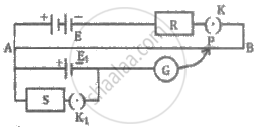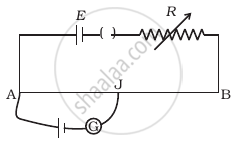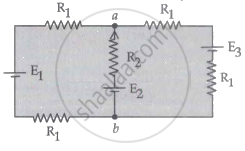Advertisements
Advertisements
प्रश्न
Would you prefer a voltmeter or a potentiometer to measure the emf of a battery?
उत्तर
A potentiometer is preferred to measure the emf of a battery, as it gives a more accurate result. This is because a potentiometer uses the null method to measure emf and it hardly draws any current from the primary circuit.
When a voltmeter is used in the circuit, its equivalent resistance is connected parallel to some element of the circuit. This changes the overall current in the circuit and, hence, the potential difference to be measured also changes. The error can be minimised if the equivalent resistance of the voltmeter is increased. However, we also need to keep in mind the heat dissipated due to high resistance while deciding the value of resistance of the voltmeter.
Hence a potentiometer is preferred.
APPEARS IN
संबंधित प्रश्न
State the principle of working of a potentiometer.
State the advantages of potentiometer over voltmeter.
Why should not the jockey be slided along the potentiometer wire?
What will be the effect on the position of zero deflection if only the current flowing through the potentiometer wire is decreased?
The resistance of a potentiometer wire is 8 Ω and its length is 8 m. A resistance box and a 2 V battery are connected in series with iL What should be the resistance in the box if it is desired to have a potential drop of 1 µV/mm?
The emf of a cell is balanced by a length of 120 cm of a potentiometer wire. When the cell is shunted by a resistance of 10 Ω, the balancing length is reduced by 20 cm. Find the internal resistance of the cell.
A voltmeter has a resistance of 100 Ω. What will be its reading when it is connected across a cell of emf 6 V and internal resistance 20 Ω?
In a potentiometer experiment, when the galvanometer shows no deflection, then no current flows through ____________.
The resistivity of potentiometer wire is 40 × 10-8 ohm - metre and its area of cross-section is 8 × 10-6 m2. If 0.2 ampere current is flowing through the wire, the potential gradient of the wire is ______.
A cell of e.m.f. 'E' is connected across a resistance 'R'. The potential difference across the terminals of the cell is 90% ofE. The internal resistance of the cell is ______.
Two students X and Y perform potentiometer experiment separately and null point was obtained as shown in diagram. During the experiment, ______.
- X increases the value of R (resistance)
- Y decreases the value of S (resistance)
The position of null point obtained by students X and Y respectively.

In the potentiometer experiment, cells of e.m.f. E1 and E2 are connected in series (E1 > E2). the balancing length is 64 cm of the wire. If the polarity of E2 is reversed, the balancing length becomes 32 cm. The ratio `E_1/E_2` is ______
In a potentiometer of 10 wires, the balance point is obtained on the 7th wire. To shift the balance point to 9th wire, we should ______.
In a potentiometer circuit a cell of EMF 1.5 V gives balance point at 36 cm length of wire. If another cell of EMF 2.5 V replaces the first cell, then at what length of the wire, the balance point occurs?
AB is a potentiometer wire (Figure). If the value of R is increased, in which direction will the balance point J shift?

For the circuit shown, with R1 = 1.0 Ω, R2 = 2.0 Ω, E1 = 2 V, and E2 = E3 = 4 V, the potential difference between the points 'a' and 'b' is approximately (in V) ______.

The emf of the cell of internal resistance 1.275 Ω balances against a length of 217 cm of a potentiometer wire. Find the balancing length when the cell is shunted by a resistance of 15 Ω.
A particle carrying 8 electron charges starts from rest and is accelerated through a potential difference of 9000 V. Calculate the KE acquired by it in keV.
What is the internal resistance of the cell?
Draw neat labelled diagram of potentiometer as voltage divider.
